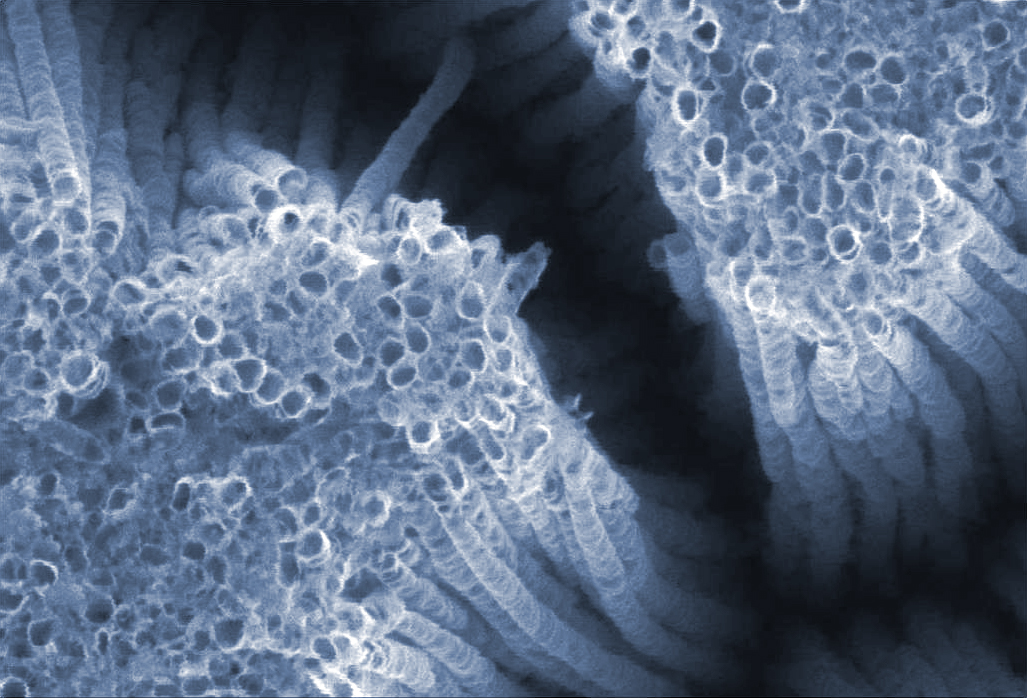Titania and Titanate Nanostructures (BNL 15-26)
A method of synthesizing titanate and titania nanostructures and assemblies of them with controlled properties
Traditionally, synthesis of nanomaterials has relied on a number of imperfect approaches, like "top-down" and "bottom-up" methods. These methods are limited in terms of available shapes and sizes for the construction of nanomaterials. The chemical structure of nanomaterials could be controlled more efficiently if one could begin with nanoscale precursors. Nanocrystallites of TiO2 (titania) have electronic, optoelectronic, and catalytic properties, coupled with high surface areas, porosities, low cost, and chemical stability; because of this, researchers have wanted to synthesize titania nanostructures. The issue lies in rationally controlling the size and shape of resulting titania nanoscale products; prior to this invention, a solution has not been reported. Another area of nanotechnology focuses on preparing higher-order assemblies of nanostructures. Before this invention, a method for preparing higher-order titania and titanate nanostructure assemblies (without the use of templates) has not been provided.
This technology is a method of making anatase nanomaterials comprising multiple aspects. It includes mixing titania powder with an alkali metal hydroxide solution to form a mixture, and then heating this mixture to form a precipitate composed of one-dimensional alkali metal hydrogen titanate nanomaterials. These nanomaterials are then neutralized to form hydrogen titanate nanomaterials, which are then hydrothermally processed to form anatase nanomaterials. Hydrothermal processing means dispersing the hydrogen titanate nanomaterials in water under neutral conditions and heating the water at about 100-200 degrees Celsius. A method of making a micrometer scale spherical aggregate is described. An alkali metal hydroxide solution is mixed with a peroxide solution and a source of titanium. This mixture is heated to form a precipitate of the spherical aggregate; this aggregate has a multitude of one dimensional alkali metal hydrogen titanate nanostructures. These one dimensional nanostructures radiate from a hollow central core, creating a spherical aggregate.
 Titanium Dioxide TiO2, National Institute of Standards and Technology, www.flickr.com/photos/63059536@N06/8051508739, US public domain.
Titanium Dioxide TiO2, National Institute of Standards and Technology, www.flickr.com/photos/63059536@N06/8051508739, US public domain.
controlled preparation of titanate and titania products through simple one-pot assembly processes - methods allow for predictive formation of different sizes and shapes of Resulting products - Produces chemically pure crystalline products - Does not require the use of mineralizers or anionic additives - methods of making titanate and titania nanostructure assemblies that do not require templates - These templates usually produce Amorphous or Semi crystalline products - methods are easily scaled up without loss of structure
- Nanocrystallites of TiO2 are of great interest for photocatalysts, gas sensors, pigments, and photovoltaic applications - Formation of nanowires and other nanomaterials
Patented
[9,365,432](https://patents.google.com/patent/US9365432) [8,440,162](https://patents.google.com/patent/US8440162)
Available for licensing.
Development partner,Commercial partner,Licensing
Patent Information:
| App Type |
Country |
Serial No. |
Patent No. |
Patent Status |
File Date |
Issued Date |
Expire Date |
|